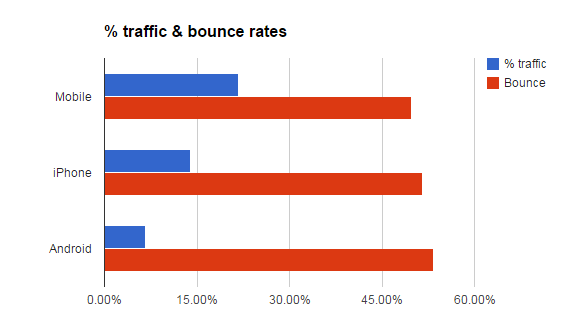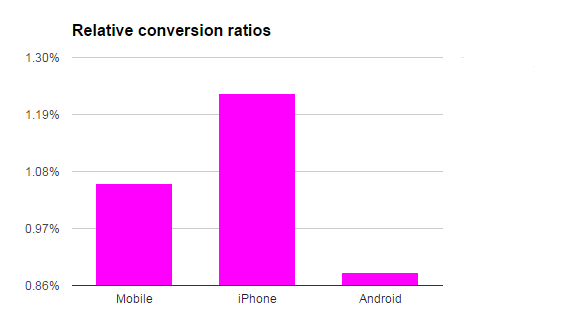Executive summary: a study and comparative benchmarking study on the behaviour of Android and iPhone mobile devices on e-commerce websites. Mobile traffic to e-commerce websites is at 21.66%: Android contributes with 6.59%. iPhones convert nearly one third better at 1.23% versus 0.88%. Sites with mobile support converted over twice as well (1.31% versus 0.55%), with a 4%+ reduction in the bounce rate.
We were recently asked by a client for our views on Android, relative to other mobile platforms. As a result, we decided to conduct a comparative benchmarking study on different small-screen mobile devices (to be precise, those classified as "mobile" by Google Analytics.
First, let's look at Android as a platform more generally. According to research firm Gartner, 79% of all smartphones sold between April and June this year were running Android: 177.9m handsets compared to Apple's 31.9m iPhones.
There are challenges with Android from a technical and development perspective: especially regarding development and testing costs. Developing & testing iOS apps means ensuring they work nicely on a small range of iPhones and/or iPads: generally 6-8 different devices depending how far back the developer wants to go. On Android, it's a different story: nearly 12,000 different devices out there in the hands of people, with a wider range of screen sizes, processors and versions of the Android software still in use, leaving apart the resources required to support live websites, if there are unspotted bugs on particular & obscure models.
Graphic showing Android device fragmentation
Android's particular challenge is "fragmentation". [See http://opensignal.com/reports/2014/android-fragmentation for a good analysis of this].
On top of this, device manufacturers tend to produce their own variants on the system: for example, Samsung’s TouchWiz and HTC's Sense which can change the look of various default elements. Plus, no other smartphone platform boasts such a proliferation of different screen sizes. Designing, coding & testing layouts and content that works well across all these screens is hugely challenging. Across the dozen or so iPhones and iPad varieties there are just 4 different physical screen sizes!
We decided to look at the numbers from Google Analytics across a number of e-commerce websites (all built with Magento and all likely to have a strong mobile customer base). We looked at 15 websites, with close to 2 million visitors over the last 30 days (October-November 2014), generating over 70,000 orders. Sites measured included Micro-scooters, Atterley Road, Donald Russell, Force4, Loake, This Works, RSPB's online shop, Christopher Ward, Tuff Luv, Van Dal, Motocaddy, Bella di Notte, BHF & BBC Children in Need's shop.
| % traffic | Bounce rate | Conversion | |
| All traffic | 100% | 35.61% | 3.78% |
| All mobile devices | 21.81% | 49.80% | 1.06% |
| iPhone traffic | 13.97% | 51.64% | 1.23% |
| Android traffic | 6.63% | 53.42% | 0.88% |
What can we learn from this?

% traffic and bounce rates from mobile devices

% traffic and bounce rates from mobile devices
Which Android devices are popular?
By far and away the preferred Android devices for mobile shopping are Samsung's. Here's a list:
Galaxy S III (in mini form as well)
Galaxy S IV (in mini form as well)
Galaxy S5
Galaxy Note 3
Of the non-Samsung devices, only the Moto G & HTC One appear the top 10.
We reiterate that overall, Android is extremely fragmented and even the Samsung domination barely accounts for 20-30% of the total.
As part of the same study, we also observed the overall behaviour of websites with some form of mobile-specific support - whether responsive or mobile-optimised. Sites with mobile support converted over twice as well (1.31% versus 0.55%), with a 4%+ reduction in the bounce rate.
Appendix
By way of additional insight, one of our charity clients conducted a large fund-raising programme in the same period, with a very high proportion of mobile visitors (46%) - the site is not in anyway optimised for mobile. The numbers are similar:
Recommendation
Overall, there is very little difference in the performance of Android versus iPhone traffic. It does not make sense to develop, test and support a wide range of Android devices - either for the Magento agency or the client. However, if there are known technical glitches on specific (and popular devices) which are effecting economic performance or customer satisfaction, these should be remedied on a case-by-case basis.
What is critical - and increasingly more so -is some form of mobile support (whether responsive or mobile-optimised). This is easily justified by the more than doubling of the conversion ratio for with and without native mobile support: economically, this figure factored against the amount of traffic and an average order value can be used to calculate the return.


